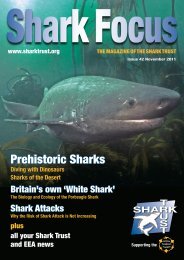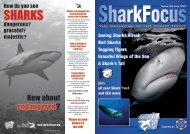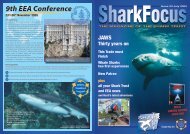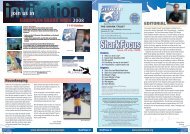Common Stingray Dasyatis pastinaca - The Shark Trust
Common Stingray Dasyatis pastinaca - The Shark Trust
Common Stingray Dasyatis pastinaca - The Shark Trust
Create successful ePaper yourself
Turn your PDF publications into a flip-book with our unique Google optimized e-Paper software.
1<br />
Dorsal view <br />
Scientific name<br />
<strong>Common</strong> <strong>Stingray</strong> <strong>Dasyatis</strong> <strong>pastinaca</strong><br />
<strong>Dasyatis</strong> <strong>pastinaca</strong> (Linnaeus 1758).<br />
diStribution<br />
Southern Norway to the northern Mediterraneanvii including<br />
the western Balticiii and the Black Seax .<br />
Map base conforms with ICES grid squares.<br />
2<br />
No records<br />
Occasional<br />
Range<br />
3<br />
common name<br />
identification<br />
1 Short snout with straight leading edges of disc.<br />
2 Long, thin tail up to 1.5 times the length of the bodyvi .<br />
3 Spine on tail up to 12cm long with 74 –98 <br />
serrationsvi .<br />
colour<br />
Dorsal surface uniform dark brown to olive.<br />
Ventral surface white with dark marginsvii .<br />
Ventral view <br />
COMMON STINGRAY, Blue <strong>Stingray</strong>, Fire Flaire,<br />
Pastenague Commune (Fr), Raya Latigo Comun (Es),<br />
Stechroche (De), Pastinaca (It), Uge (Pr), Pijlstaartrog (Ne).<br />
biology and Size<br />
Mature: 46cm , 43cm v . Max TL: 250cm,<br />
DW: 60cmi .<br />
Give birth in shallow waters to 4–7 youngiv .<br />
Feed predominantly on crustaceansv with some small<br />
fish and molluscsvi .<br />
ne atl med blK<br />
nt<br />
dd ne atl:<br />
JdP
<strong>Common</strong> <strong>Stingray</strong> JDP01/01/09<br />
Supported by:<br />
Similar SPecieS<br />
habitat<br />
From shallows to 200m.<br />
Most common to 60m.<br />
Found over soft substrates such as sand and mudviii .<br />
conServation StatuS<br />
<strong>Dasyatis</strong> <strong>pastinaca</strong>,<br />
<strong>Common</strong> <strong>Stingray</strong><br />
Pteroplatytrygon violacea,<br />
Pelagic <strong>Stingray</strong><br />
<strong>Dasyatis</strong> centroura,<br />
Roughtail <strong>Stingray</strong><br />
<strong>Dasyatis</strong> tortonesi, Tortonese’s <strong>Stingray</strong><br />
(not illustrated).<br />
Very few data. Appears to be rare in northeast Atlantic<br />
and has declined in the Bay of Biscay. Stable in the<br />
Mediterraneanii .<br />
Red List status: Data Deficient (2008).<br />
Near Threatened in northeast Atlantic.<br />
teeth<br />
28–43 rowsix .<br />
commercial imPortance<br />
No targeted fishery but taken as bycatch in trawl,<br />
longline, trammel net and rod and line fisheries.<br />
Often discardedii .<br />
Wings are sold smoked and dried-salted for human<br />
consumption, liver for oil and carcass for fishmealvi .<br />
handling and thorn arrangement<br />
Handle with care.<br />
Large venomous spine on tail.<br />
In extreme cases can cause paralysis xi .<br />
referenceS<br />
i. Ferretti, F. et al; 2005. ICES.<br />
<strong>Common</strong> <strong>Stingray</strong><br />
ii. Gibson, C. et al; 2006. IUCN SSC <strong>Shark</strong> Specialist Group.<br />
iii. Greenberg, R; 2008. Oceana.<br />
iv. IBSS; Unknown.<br />
v. Ismen, A; 2003. Fisheries Research, Vol. 60 (1): 169–176.<br />
vi. Luna, S. M; 2008. Fishbase.<br />
vii. Schwartz, F. J; 2007. Smithiana, Publications in Aquatic Biodiversity,<br />
Bulletin 8: 41–52<br />
viii. Serena, F; 2005. FAO.<br />
ix. Van der Elst, R. et al; 1997. Random House Struik.<br />
x. Whitehead, P. J. P. et al; 1986. UNESCO.<br />
xi. Wölfl, D; 1994. Draga.

















